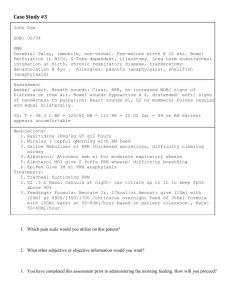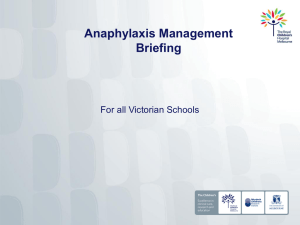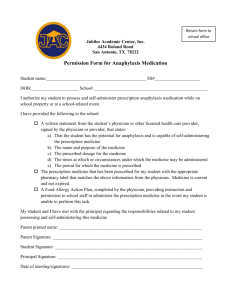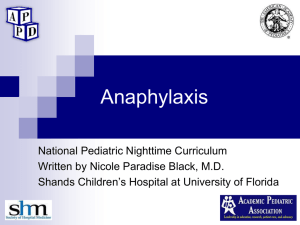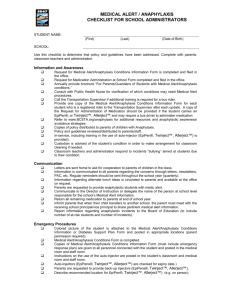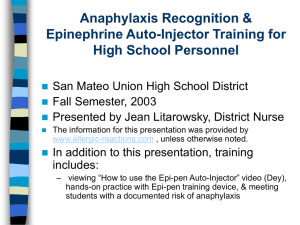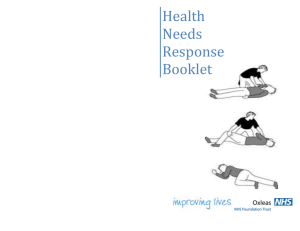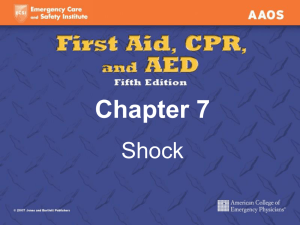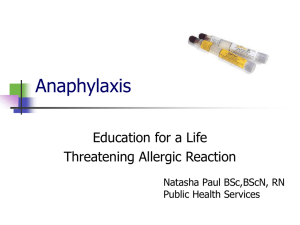anaphylaxis
advertisement
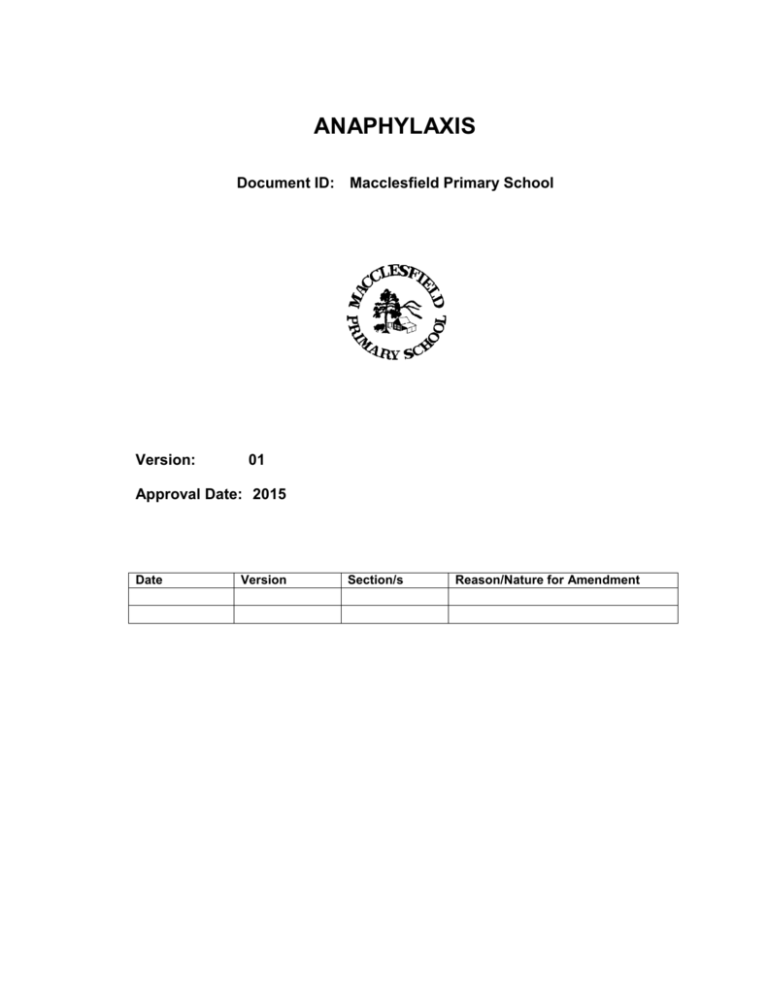
ANAPHYLAXIS Document ID: Version: Macclesfield Primary School 01 Approval Date: 2015 Date Version Section/s Reason/Nature for Amendment 1. Rationale/Purpose Anaphylaxis is a severe, rapidly progressive allergic reaction that is potentially life threatening. The most common allergens in school aged children are peanuts, eggs, tree nuts (e.g. cashews), cow’s milk, fish and shellfish, wheat, soy, sesame, latex, certain insect stings and medication. The key to prevention of anaphylaxis in schools is knowledge of those students who have been diagnosed at risk, awareness of triggers (allergens), and prevention of exposure to these triggers. Partnerships between schools and parents are important in ensuring that certain foods or items are kept away from the student while at school. Adrenaline given through an EpiPen® autoinjector to the muscle of the outer midthigh is the most effective first aid treatment for anaphylaxis. The school will comply with Ministerial Order 706 and guidelines on Anaphylaxis management. 2. Aims/Objectives To raise awareness about anaphylaxis and the school’s anaphylaxis policy in the school community. To ensure that each staff member has adequate knowledge about allergies, anaphylaxis and the school’s policy and procedures in responding to an anaphylactic reaction. To engage with parents/carers of students at risk of anaphylaxis in assessing risks, developing risk minimisation strategies and management strategies for the student. To ensure that each staff member has adequate knowledge about allergies, anaphylaxis and the school’s policy and procedures in responding to an anaphylactic reaction. 3. Scope To provide, as far as practicable, a safe and supportive environment in which students at risk of anaphylaxis can participate equally in all aspects of the student’s schooling. In the event of an anaphylactic reaction, the school’s first aid and emergency response procedures and the student’s Individual Anaphylaxis Management Plan must be followed. 4. Responsibilities Who/Role Responsibility Admin Team Ensure enrolment procedure gathers correct information Seek GP plan from family at the time of enrolment Add detail to CASES 21 Generate medical alert reports for staff Class teacher & Aware of students with medical alert and the school team appropriate treatment / management plan Principal Provide resources and support for implementation of management and treatment plan 5. Implementation INDIVIDUAL ANAPHYLAXIS MANGEMENT PLANS Note: The template of an individual anaphylaxis management plan (included as an appendix) can be found on Page 18 Anaphylaxis Guidelines for Victorian Government Schools or the Department’s website: http://www.education.vic.edu.au/wellbeing/support/anaphyl.htm The principal will ensure that an individual management plan is developed, in consultation with the student’s parents, for any student who has been diagnosed by a medical practitioner as being at risk of anaphylaxis. The individual anaphylaxis management plan will be in place as soon as practicable after the student enrolment in the school and where possible before their first day of school. The individual anaphylaxis management plan will set out the following: • Information about the diagnosis, including the type of allergy or allergies the student has (based on a diagnosis from a medical practitioner). • Strategies to minimize the risk of exposure to allergens while the student is under the care or supervision of school staff, for in-school and out of school settings including camps and excursions. Note: Appendix 2 (pp 21 – 23) of the Anaphylaxis Guidelines for Victorian Government Schools contains advice about a range of prevention strategies that can be put in place. • The name of the person/s responsible for implementing the strategies. • Information on where the student’s medication will be stored. • The student’s emergency contact details. • An emergency procedures plan (ASCIA Action Plan), provided by the parent, that: - sets out the emergency procedures to be taken in the event of an allergic reaction; - is signed by a medical practitioner who was treating the child on the date the practitioner signs the emergency procedures plan; and - includes an up to date photograph of the student. Note: The red and blue ‘ASCIA Action Plan’ is the most common form of emergency procedures plan that is provided by medical practitioners to parents when a child is diagnosed as being at risk of anaphylaxis. This plan (included as an appendix) can be found on page 20 of the Anaphylaxis Guidelines or downloaded from http://www.education.vic.edu.au/wellbeing/support/anaphyl.htm The student’s Individual Anaphylaxis Management Plan will be reviewed, in consultation with the student’s parents/ carers: • annually, and as applicable, • if the student’s condition changes, or • immediately after a student has an anaphylactic reaction at school. It is the responsibility of the parent to: • provide the emergency procedures plan (ASCIA Action Plan). • inform the school if their child’s medical condition changes, and if relevant provide an updated emergency procedures plan (ASCIA Action Plan). • provide an up to date photo for the emergency procedures plan (ASCIA Action Plan) when the plan is provided to the school and when it is reviewed. COMMUNICATION PLAN Note: Page 15 of the Anaphylaxis Guidelines for Victorian Government Schools has advice about strategies to raise staff and student awareness, working with parents/carers and engaging the broader school community The principal will be responsible for ensuring that a communication plan is developed to provide information to all staff, students and parents about anaphylaxis and the school’s anaphylaxis management policy. The communication plan will include information about what steps will be taken to respond to an anaphylactic reaction by a student in a classroom, in the school yard, on school excursions, on school camps and special event days. Volunteers and casual relief staff of students at risk of anaphylaxis will be informed of students at risk of anaphylaxis and their role in responding to an anaphylactic reaction by a student in their care by the Principal or Assistant Principal. All staff will be briefed once each semester on: • the school’s anaphylaxis management policy • the causes, symptoms and treatment of anaphylaxis • the identities of students diagnosed at risk of anaphylaxis and where their medication is located • how to use an autoadrenaline injecting device • the school’s first aid and emergency response procedures Note: The Anaphylaxis DVD may be used for this purpose. STAFF TRAINING AND EMERGENCY RESPONSE Teachers and other school staff who conduct classes which students at risk of anaphylaxis attend, or give instruction to students at risk of anaphylaxis must have up to date training in an anaphylaxis management training course. At other times while the student is under the care or supervision of the school, including excursions, yard duty, camps and special event days, the principal must ensure that there is a sufficient number of staff present who have up to date training in an anaphylaxis management training course. The principal will identify the school staff to be trained based on a risk assessment. This may mean the majority or all staff will need to be trained. Note: The risk assessment management checklist (included as an appendix) can be downloaded from http://www.education.vic.edu.au/wellbeing/support/anaphyl.htm . Training will be provided to these staff as soon as practicable after the student enrols. Wherever possible, training will take place before the student’s first day at school. Where this is not possible, an interim plan will be developed in consultation with the parents. The school’s first aid procedures and students emergency procedures plan (ASCIA Action Plan) will be followed in responding to an anaphylactic reaction. The following risk minimisation strategies will be used by the school: Food allergens discouraged from being eaten within the classrooms Food allergens discouraged from being sold in the canteen Food allergens discouraged from being used in Breakfast Club All students educated regarding the risks of food sharing Food preparation surfaces and tables wiped down regularly All food consumed before students leave the classroom Students at risk of an anaphylactic reaction have own treats box Students at risk of an anaphylactic reaction do not pick up yard litter All staff aware that students’ EpiPens are located in the general office All staff are aware that the school has purchased a backup EpiPen EpiPens are to accompany students on all camps and excursions, and where appropriate to specialist subjects and in the playground Food not consumed in transit to camps and excursion destinations Designated staff member checks the EpiPens for expiry dates Individual Action Plans are located in key, strategic areas around the school eg staffroom, office, sick bay, inside all rolls and CRT information books CRT staff and CRI staff briefed on individual students at risk of an anaphylactic reaction Music teachers briefed on danger of sharing woodwind instruments All staff trained in yard duty procedures for anaphylactic reactions All staff briefed each semester All staff trained every three years 6. Supporting Legislation or References School Policy Advisory Guide – Anaphylaxis http://www.education.vic.gov.au/school/principals/health/Pages/anaphylaxisschools.a spx 7. Definitions Item Definition 8. Evaluation/Review Period 3 years Twice annual briefing with staff 9. Appendices / Related Documents Document Number/Name Appended / Where filed
